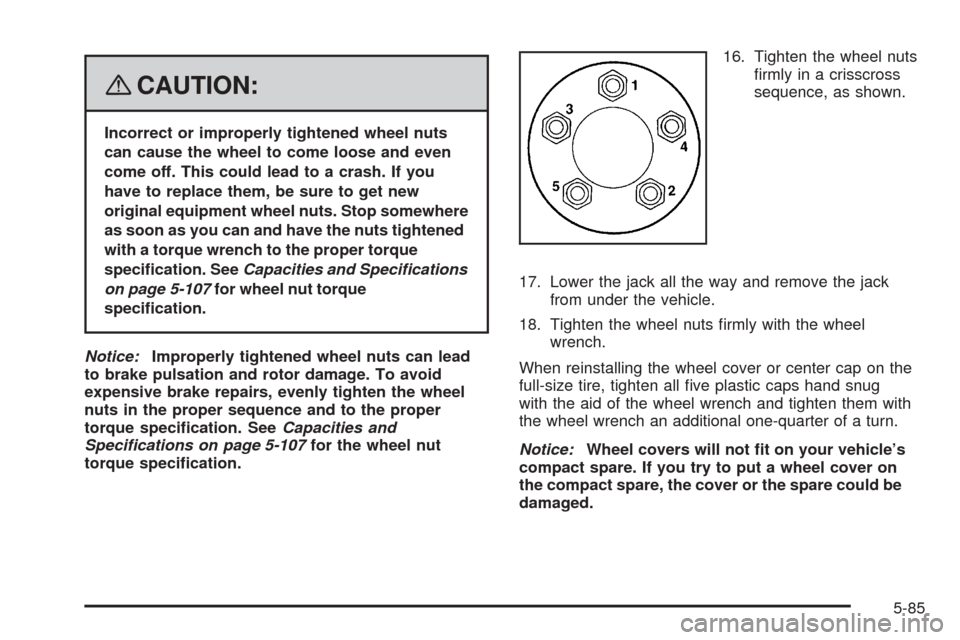brake rotor CHEVROLET EQUINOX 2008 1.G Owners Manual
[x] Cancel search | Manufacturer: CHEVROLET, Model Year: 2008, Model line: EQUINOX, Model: CHEVROLET EQUINOX 2008 1.GPages: 436, PDF Size: 2.42 MB
Page 363 of 436

{CAUTION:
Incorrect or improperly tightened wheel nuts
can cause the wheel to come loose and even
come off. This could lead to a crash. If you
have to replace them, be sure to get new
original equipment wheel nuts. Stop somewhere
as soon as you can and have the nuts tightened
with a torque wrench to the proper torque
speci�cation. SeeCapacities and Specifications
on page 5-107for wheel nut torque
speci�cation.
Notice:Improperly tightened wheel nuts can lead
to brake pulsation and rotor damage. To avoid
expensive brake repairs, evenly tighten the wheel
nuts in the proper sequence and to the proper
torque speci�cation. SeeCapacities and
Specifications on page 5-107for the wheel nut
torque speci�cation.16. Tighten the wheel nuts
�rmly in a crisscross
sequence, as shown.
17. Lower the jack all the way and remove the jack
from under the vehicle.
18. Tighten the wheel nuts �rmly with the wheel
wrench.
When reinstalling the wheel cover or center cap on the
full-size tire, tighten all �ve plastic caps hand snug
with the aid of the wheel wrench and tighten them with
the wheel wrench an additional one-quarter of a turn.
Notice:Wheel covers will not �t on your vehicle’s
compact spare. If you try to put a wheel cover on
the compact spare, the cover or the spare could be
damaged.
5-85
Page 393 of 436

Maintenance Footnotes
(a)Visually inspect brake lines and hoses for proper
hook-up, binding, leaks, cracks, chafing, etc. Inspect
disc brake pads for wear and rotors for surface
condition. Inspect other brake parts, including calipers,
parking brake, etc. Check parking brake adjustment.
(b)Visually inspect front and rear suspension and
steering system for damaged, loose, or missing parts or
signs of wear. Visually check constant velocity joints,
rubber boots, and axle seals for leaks. With 3.4L
V6 engine: Inspect electric power steering cables for
proper hook-up, binding, cracks, chafing, etc. With 3.6L
V6 engine: Inspect hydraulic power steering lines and
hoses for proper hook-up, binding, leaks, cracks,
chafing, etc.
(c)Visually inspect hoses and have them replaced if
they are cracked, swollen, or deteriorated. Inspect
all pipes, fittings and clamps; replace with genuine parts
as needed. To help ensure proper operation, a pressure
test of the cooling system and pressure cap and cleaning
the outside of the radiator and air conditioning condenser
is recommended at least once a year.(d)Inspect wiper blades for wear, cracking, or
contamination. Clean the windshield and wiper blades, if
contaminated. Replace wiper blades that are worn or
damaged. See Windshield Wiper Blade Replacement on
page 5-50andWindshield and Wiper Blades on
page 5-95for more information.
(e)Make sure the safety belt reminder light and safety
belt assemblies are working properly. Look for any
other loose or damaged safety belt system parts. If you
see anything that might keep a safety belt system
from doing its job, have it repaired. Have any torn or
frayed safety belts replaced. Also see Checking the
Restraint Systems on page 1-72.
(f)Lubricate all key lock cylinders, hood latch
assemblies, secondary latches, pivots, spring anchor
and release pawl, hood and door hinges, rear folding
seats, and liftgate hinges. More frequent lubrication may
be required when exposed to a corrosive environment.
Applying silicone grease on weatherstrips with a clean
cloth will make them last longer, seal better, and not stick
or squeak.
(g)If you drive regularly under dusty conditions, the
filter may require replacement more often.
6-7